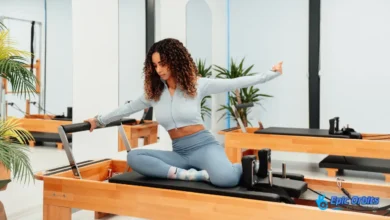Building a Sustainable Fitness Routine for Everyday Life
Create a sustainable fitness routine with our expert tips. Learn how to make exercise a habit for a healthier you today.

Did you know that about 80% of those who plan to start a new fitness routine in the new year give up by February? Many of us face this painful reality, only to find ourselves back at the beginning, wondering why we failed. The truth is, maintaining long-term health and wellness doesn’t require making drastic changes you can’t stick to. It’s about finding an exercise program that fits your life.
It’s about finding a balance that works for you, not just working out or spending hours at the gym. It’s important to make exercise a joyful part of your everyday life instead of a duty. You may change your body and become healthier without giving up the things you love by concentrating on sustainability and pleasure.
The Building Blocks of a Long-Term Fitness Routine
An exercise plan that you can stick to is the key to getting long-term health advantages. Regular exercise is essential for keeping you healthy. It helps both your body and your mind.
When it comes to exercise, “sustainable” means a regimen that you can keep up with over time without being too tired or stressed out. It’s all about finding a balance that fits your lifestyle, tastes, and physical objectives. When it comes to exercise, sustainability isn’t only about how it affects the environment. It’s also about having a fun, practical routine that is easy to stick to.
Before beginning a fitness journey, it’s important to be honest about your current fitness level. This involves assessing your strengths, weaknesses, and any physical limitations you may have. Understanding your starting point helps you set realistic goals and select exercise routines that match your abilities. For example, if your cardiovascular endurance is currently moderate, you might aim to reach a high level through consistent aerobic training. If muscle strength is low, the goal could be to bring it up to a moderate level with strength-building exercises. Meanwhile, if your flexibility is already high, the focus might simply be on maintaining it. This approach ensures progress while minimizing the risk of injury.
You may make a fitness plan that works for you and your objectives by knowing what “sustainable” means and figuring out how fit you are right now. This will help you become healthier and stay fit for longer.
Making your fitness routine goals possible
Starting a fitness journey without defined objectives is like going somewhere without a map. You need to establish objectives that are realistic and possible to reach if you want to make a fitness regimen that works and lasts. This means knowing the difference between short-term and long-term goals and using a framework that makes your goals explicit, quantifiable, attainable, relevant, and time-bound.
Short-term goals are the steps you need to take to reach your long-term goals. They provide you immediate victories that keep you going. For example, if you want to run a 5-kilometer marathon in the long term, a short-term objective may be to jog for 30 minutes without stopping. Conversely, long-term objectives assist you in maintaining focus and avoiding distractions on your fitness journey.
The SMART Goal Framework for Getting Fit:
The SMART goal framework is an excellent tool for turning vague fitness intentions into actionable plans. SMART stands for Specific, Measurable, Achievable, Relevant, and Time-bound, ensuring your objectives are clear and trackable. For instance, rather than saying “I want to get fit,” a SMART goal would be “I will be able to do 10 push-ups in a row within the next 6 weeks.”
Different types of goals offer unique benefits: short-term goals, like jogging for 30 minutes without stopping, provide quick wins and motivation; long-term goals, such as running a 5-kilometer marathon, give direction and a sense of accomplishment; and SMART goals offer clear objectives and allow for trackable progress, making it easier to stay committed and measure improvement over time.
You don’t have to be great to start, but you do have to start to be great.
You may make a workout plan that works and lasts by utilizing the SMART framework to define realistic fitness goals and balance short-term and long-term goals.
Different kinds of exercise to add to your fitness routine
A balanced diet and a well-rounded fitness regimen are similar in that they both need a variety of workouts to keep your body guessing and your health on track. Adding diverse forms of exercise to your routine not only helps you improve your physical health, but it also keeps your workouts engaging and stops you from hitting a plateau.
1. Cardiovascular Exercise: Making Your Heart Work Harder
Cardio, or cardiovascular exercise, is the most important thing you can do for your heart, stamina, and calorie burning. It’s not only about making you sweat like a hot golden retriever; it’s also about getting your heart strong so it can pump blood throughout your body. Running, biking, and swimming are among the examples. You should try to do at least 150 minutes of moderate-intensity exercise per week.
2. Strength Training: Making Bones and Muscles Stronger
Strength training transforms your body holistically. It builds muscle that you can see, but it also strengthens your bones and speeds up your metabolism. It keeps everything working smoothly and well, much like employing both security and maintenance workers for your body’s building. Include exercises that train more than one muscular group at a time, such as squats, deadlifts, and bench presses.
3. Flexibility and mobility work is the part that people often forget about.
Flexibility and mobility work is like flossing your teeth for your fitness: it’s not fun, and many people avoid it, but you’ll wish you hadn’t when you’re older and can’t tie your shoes without making noise. Adding stretching and mobility exercises to your regimen may help you move better, lower your risk of injury, and improve your overall performance. Be careful to do things like yoga or Pilates, or just spend time stretching your key muscle groups.
You don’t need a PhD in exercise physiology or to leave your day job to become a full-time gym rat to combine these diverse forms of exercise. The most important thing is to find a balance that works for you and to enjoy it. Mixing and matching activities will keep you healthy, busy, and motivated.
Making a schedule for your workouts each week
Making a weekly fitness program is hard, but you can do it in a few easy steps. The goal is to find a balance between various forms of exercise, give your body time to heal, and fit it all into your hectic schedule.
1. Finding a Balance Between Different Types of Exercise
Your workout plan should contain a combination of aerobic, weight training, and flexibility exercises. Please consider dividing your weekly training time among these groups. You may, for example, spend three days doing cardio, two days doing weight training, and one day doing flexibility exercises.
2. Finding the best number of times to work out
The frequency of workouts depends on your fitness goals, current level of fitness, and recovery ability. According to the Physical Activity Guidelines for Americans, adults should aim for at least 150 minutes of moderate-intensity cardio or 75 minutes of high-intensity cardio per week, in addition to two days of strength training that target all major muscle groups.
For beginners, working out 3–4 times per week with three days of cardio and one day of strength training is a good starting point. Intermediate exercisers may train 4–5 times per week, combining three days of cardio with two days of strength training. Advanced athletes can handle 5–6 workouts per week, incorporating four days of cardio, two days of strength training, and one day focused on flexibility. Tailoring your routine to your fitness level helps ensure progress while reducing the risk of injury.
3. Examples of 7-Day Workout Plans for Different Skill Levels
These exercise regimens cater to individuals with varying levels of fitness. A three-day full-body exercise plan is a wonderful place for a novice to start. Depending on the person’s strength, you can adjust the number of sets and repetitions. People who are at an intermediate level can do a 4-day split regimen, while those who are at an advanced level can do a 6-day split.
- Cardio on Monday for 30 minutes at a moderate level.
- Tuesday: Strength exercise for the upper body (3 sets of 8 to 12 repetitions).
- Wednesday: Take a break or do something active to heal, like yoga.
- Thursday: 30 minutes of moderate-intensity cardio.
- Friday: 3 sets of 8–12 repetitions of strength training for the lower body.
Change these programs to fit your schedule and tastes, making sure you have time to relax and heal. Stretching or going for a leisurely stroll are examples of active recuperation activities you may try on your day off.
A Beginner’s Guide to Getting a Fitness Routine Right
Starting a workout program is like learning to drive: you go slowly at first and then speed up. As a novice, it’s important to take it gently with your new fitness routine so you don’t get hurt or burned out. A good beginner’s fitness program should cover the basics of starting and moving at your own pace.
1. The 3-Day Full Body Approach: Starting Slow
The three-day full-body technique is a fantastic way to start becoming healthy. This means going to the gym three times a week and doing full-body workouts every time. It provides you with ample time to adjust to new movements, focus on your form, and recuperate. You may go forward swiftly and avoid overdoing it by beginning slowly.
2. Fitness Routine: Important Exercises for Newbies
As a novice, it’s important to concentrate on the most important workouts that provide you the greatest benefit. These are squats, lunges, push-ups, and rows. You can modify these exercises to suit your fitness level and gain strength at the base. For instance, you may start with knee push-ups and work your way up to full push-ups as you become stronger.
If you follow this beginner’s guide to a fitness program, you’ll be well on your way to making working out a regular part of your life. Pay attention to your body and change your program as required.
Fitness Routine: Strategies for Intermediate Workouts
When you’re in intermediate training, it’s like being a teenager in fitness: you’re not a novice, but you’re not advanced yet either. You have good form and can lift more weight, but you’re still on the way to peak fitness.
1. Four-day fitness routine split schedule
With a 4-day split plan, you may work on certain muscle groups more intensively. This method is like going from a point-and-shoot camera to one with interchangeable lenses, which lets you do more intricate work. You may get more out of your exercise by spending more days on various muscle groups. This will help your muscles expand.
2. Progressive Overload: How to Get in Better Shape
The idea behind progressive overload is to make your muscles work harder by slowly adding more weight or resistance to what you’re doing. It’s like telling your body, “That was too easy,” so it creates more muscle in case the next trial is harder. This plan is essential for getting over plateaus and making steady progress on your fitness quest.
Consider monitoring your progress to ensure these techniques are effective. It may be a little too much to write down every rep in a comprehensive diary, but utilizing a log or an app can help you keep track of your progress and introduce changes to your training regimen when you need to.
More advanced fitness routine choices
If you’ve been working out regularly for two years or more, it’s time to think about an advanced fitness regimen. At this point, you’ve probably developed a strong base, and now it’s time to test your limitations. Advanced routines are like gourmet cooking: they take more time, resources, and skill, but if you know what you’re doing, the results may be amazing.
1. The Push-Pull-Legs Pattern for 6 Days
The push-pull-legs pattern for six days is a challenging exercise plan that has you going to the gym six days a week with one day off in between. This plan follows a predetermined schedule, working each muscle group twice a week and using supersets to get the most muscular growth. You can maximize your gym time by combining compatible muscle groups. This regimen will help you get the maximum volume and recovery.
- For push day, do exercises like the bench press, shoulder press, and tricep extensions.
- Pull day: Focus on pull-ups, rows, and bicep curls.
- On leg day, do squats, lunges, and leg presses.
2. Using specialized training methods
To get in better shape, you need to use specific training methods. You may go over plateaus and make big improvements using techniques like drop sets, supersets, and periodization. To use these advanced tactics, you must know your body and its limits, so pay attention to what it tells you and adjust accordingly.
Some important methods to look into are
- Drop sets: Do a set until you can’t do any more, then lower the weight and do more repetitions.
- Supersets: To make your workouts more effective and intense, pair exercises that work different muscle groups.
- Periodization is changing up your routine over time to avoid hitting a plateau and overtraining.
Getting into the habit of working out every day
For long-term fitness success, it’s important to make exercise a regular habit. To achieve this, you need to know how habits are formed and use practical methods to stay consistent.
1. The Psychology Behind Making Habits
To develop a habit, you need a signal, a routine, and a reward. For exercise, the cue may be getting up at a given time, the routine is the activity itself, and the reward is the sense of achievement or the endorphins generated during exercise. To make exercise a non-negotiable part of your everyday life, you need to understand this habit cycle.
2. Useful Advice for Staying Consistent
The first step to making exercise a consistent habit is to schedule it into your daily routine. Choose a time of day that works best for you—whether early in the morning, during your lunch break, or right after work—and try to exercise at the same time each day, since consistency is key. For example, morning workouts like brisk walking or yoga can boost energy and set a positive tone for the day.
Lunch break exercises, such as a quick workout or stretching, help reduce stress and increase productivity, while after-work sessions focused on cardio or strength training can improve mood and support weight management. By understanding how habits form and following simple strategies, you can successfully integrate exercise into your daily life and achieve your fitness goals.
How to Incorporate a Fitness Routine into Your Busy Life
You can get healthy quickly if you do it wisely. Many people think that working out takes a lot of time, but that’s not true at all. If you use the appropriate tactics, you can fit in beneficial exercises even if you have a lot going on.
1. Workout Plans That Save Time
One of the most effective ways to fit exercise into a busy schedule is by using time-efficient workout plans. Techniques like HIIT, circuit training, and supersets allow you to maximize results in less time. For instance, a 20-minute HIIT session can provide similar benefits to a 60-minute steady-state cardio workout, improving cardiovascular health and boosting metabolism.
Circuit training, which typically lasts about 30 minutes, offers a full-body workout that enhances muscular endurance, while 25-minute supersets focus on strength development and muscle toning. These strategies not only save time but also help accelerate fat loss and promote overall heart health, making them ideal for people with hectic schedules.
2. Short workouts throughout the day
Adding mini-workouts throughout your day is another beneficial way to stay fit. If you can’t find a 30-minute block of time, consider performing at least three 10-minute mini-workouts. You may do something as basic as taking the stairs instead of the elevator, performing push-ups during commercial breaks, or going for a little stroll during your lunch break. These little exercises add up and might help you get in shape a lot.
You may perform calf raises while you’re on the phone for a conference call or push-ups on the kitchen counter while you wait for your coffee to boil. These little things not only make you healthier, but they also give you more energy and make you more productive all day long.
How Nutrition Affects Your Fitness Routine
Your food is the base on which you build your fitness objectives. It gives you the energy you need for exercises and helps you recuperate. Exercise at the gym is what makes muscles and strength grow, but diet is highly important for recovery and getting the most out of your workouts.
To get the most out of your workouts, you need to provide your body the correct nutrition. Carbs can fuel your muscles before a workout, especially if it’s over an hour of high-intensity activity. It’s also important to make sure you’re getting enough calories, protein, carbs, and fats depending on how hard you’re exercising and what your body objectives are.
Nutrition is still highly important for recuperation after your exercise. Eating carbohydrates after working out may help your muscles recuperate by refilling their glycogen reserves and letting amino acids get into them. Furthermore, protein helps your muscles recover after exercise, fix damage to tissue, and develop muscular mass. This makes it an important part of your post-workout diet.
Rest and Recovery: The Missing Part
Rest and recuperation are the hidden heroes of every exercise regimen. They let your body heal and become stronger. When you do things that make your muscles stronger, you create microscopic rips in their fibers, which makes them painful and achy. This procedure may seem scary, but it’s a sign that your muscles are becoming stronger.
Not letting your muscles rest might make your injuries worse and stop them from becoming stronger. But it doesn’t imply you have to do nothing on your days off. You can still move about a little, even if you’re not too uncomfortable or fatigued. Active rest, like walking and stretching, may help muscles that are sore after working out feel better and recover faster.
1. Days of active recovery vs. passive recovery
It’s critical to know the difference between active and passive recuperation. Yoga or a leisurely stroll are examples of gentle activity that helps the body recuperate. On the other side, passive rehabilitation means doing very little, like lying on the sofa or watching a lot of Netflix. Both have their uses, but adding active recovery may help you become fitter overall.
- Active recuperation gets blood flowing, which may help repair muscle fibers that have been injured.
- It may also help keep your muscles flexible and ease discomfort.
- Light swimming, biking, or even a quick stroll are some examples.
2. Sleep: Your Secret Weapon for Getting Fit
Sleep is an important part of rehabilitation since it helps your body work better naturally. While you sleep, your body fixes and replaces damaged cells, grows muscle and bone, and makes your immune system stronger. Getting enough sleep every night may greatly improve your fitness outcomes without you having to do anything extra.
- To help your body heal, try to get 7 to 9 hours of sleep each night.
- Set up a nightly routine to let your body know it’s time to go to sleep.
- Make your bedroom cold, dark, and quiet to help you sleep better.
Changing Your Fitness Routine as You Get Older
Fitness is a lifetime endeavor, and as you get older, you need to change your regimen to fit your body’s changing demands. In your 40s and beyond, you may notice changes in your appearance, energy, and recovery time. But with the correct changes, you may still get the advantages of regular exercise and stay healthy and active.
1. Changing Exercises for a Smoother Ride
As we age, it’s natural to gradually lose muscle and bone mass, but a consistent resistance training routine can help slow or even prevent this decline. For older adults or those with joint issues, some exercises may need to be modified to reduce strain. For example, goblet squats can replace back squats to lower back stress and make it easier to maintain proper form. Similarly, triceps pushdowns can substitute for dips, placing less stress on the shoulders and elbows.
High-impact aerobics can be swapped for low-impact aerobics or brisk walking, which reduces joint strain and lowers the risk of injury. Because the likelihood of injury increases with age, it’s important not to push too hard and to allow longer rest periods between exercises, giving the body time to recover and heal.
2. Focusing on how long things last and how well they work
As you become older, your exercise objectives may change. You could discover that keeping things functioning and lasting becomes more essential than just how they seem. This means putting activities that make your everyday life better at the top of your list, like being able to play with your grandchildren or put on your socks without any trouble. You may have a higher quality of life as you become older if you concentrate on functional fitness.
In the end, changing your workout regimen as you get older is all about paying attention to your body and making changes that will help you stay healthy and happy. You may keep getting the advantages of exercise and stay healthy far into your senior years if you do it the proper way.
Getting beyond common problems with fitness routine
It’s normal to run into problems with your exercise program, but understanding how to deal with them may make a big difference. Regardless of your athletic experience, plateaus, injuries, and a lack of desire can hinder your growth. But if you take the appropriate steps, you can get beyond these problems and keep going on your way to a healthier, fitter self.
1. How to Handle Plateaus
Plateaus are times when your body appears to be fighting against making further progress. If you want to break through, consider modifying your training program or making it harder. This jolt to your body might help you make fresh progress and get you going ahead again.
2. Avoiding and dealing with injuries
Stop and relax if you experience pain or discomfort while working out. If you continue exercising despite experiencing pain, you may sustain an injury. Warm up before working out and cool down afterward to avoid getting hurt. If you experience pain, seek alternative exercises that won’t exacerbate the issue, enabling you to continue pursuing your fitness goals.
3. How to Stay Motivated When Things Slow Down
When progress slows, it’s common for motivation to drop, but there are effective strategies to stay on track. If you hit a plateau, try changing your workout routine or increasing the intensity to challenge your body in new ways. In the case of injuries, focus on rest, perform proper warm-ups and cool-downs, and consider alternative exercises to maintain activity without aggravating the injury.
For periods of low motivation, set new, realistic goals, find a workout buddy, and celebrate small victories along the way. These approaches help maintain dedication, making it easier to continue progressing toward your fitness objectives.
Conclusion
Your fitness path is different from anybody else’s; therefore, the best program is one that changes with your needs and objectives. As you think about how you went from being a fitness beginner to a lifelong exercise lover, keep in mind that it’s more about sticking with it than being perfect.
The best workout plan isn’t the one that promises the quickest results; it’s the one you can stick with through good times and bad. When you make exercise a regular part of your life, you’re doing something good for yourself that will help you in almost every area of your life, from your health and advantages to your mental clarity and the energy you need to follow your aspirations.
Take the first step today, no matter how tiny, and remember that you can’t become fit in a day; it takes time. You will be glad you began now instead of waiting for the right moment.



